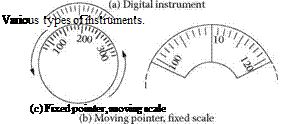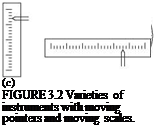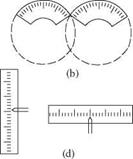The choice from amongst the many different types of visual instruments available depends on the information to be presented and how it will be used. Figure 3.1 shows some of the more common types of instruments. Figure 3.1a shows a digital instrument which displays the various numbers directly. The instrument may have mechanically or electronically generated numbers. Figure 3.1b shows instruments with moving pointers and fixed scales, whereas in Figure 3.1c the instruments have fixed pointers and moving scales.
There are many variants of pointer instruments. Figure 3.2 gives examples of some of these:
1. Round and sector-shaped instruments (Figure 3.2a) are recommended for check and qualitative readings. Round ones are usually better than sectorshaped ones, but take up more room.
2. Vertical and horizontal scales with moving pointers (Figure 3.2b) are also good for check readings. They do not give as much information as that provided by the angle of the pointer in round or sector-shaped instruments. However, this type of instrument takes up little space.
3. Round and sector-shaped instruments with fixed pointers (Figure 3.2c) can be recommended where the whole scale does not need to be seen for quantitative readings with slow changes. Their design allows a relatively long scale to be used without taking up much panel space, but they may need a relatively large area behind the panel.
a. Digital instrument
b.
 |
Moving pointer, fixed scale
|
4 |
3 |
7 |
0 |
0 |
 |
|
 |
|
5. Figure 3.2d shows vertical and horizontal instruments with fixed pointers. This type of instrument can also have a very long scale (see Figure 3.3). They cannot be recommended for cases other than where a very long scale is required.
Table 3.1 summarises the recommended areas of usage for different types of pointer instrument.
In certain cases, it may be desirable to choose other designs of instruments. One may wish to use the design to show the function of the instrument. Figure 3.4 gives examples of a round instrument with moving pointer indicating speed. The angle of the material or feature being controlled is shown on a sector-shaped instrument with moving pointer. The level is shown on a vertical instrument, and time changes are plotted out on paper with a moving pointer; the most recent time is marked at a suitable time interval.


